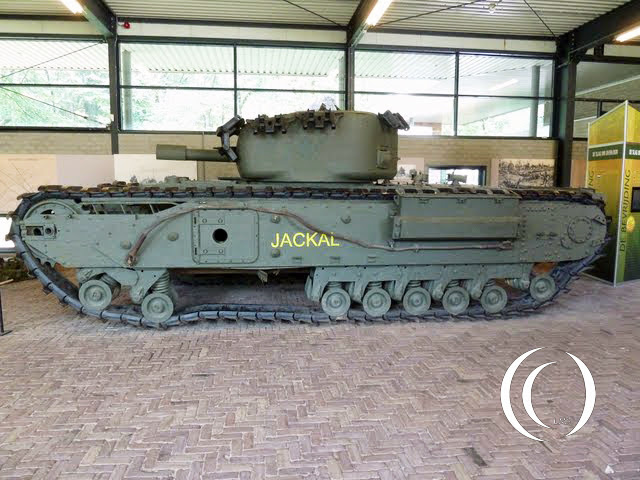
An email from Christine
In 2011 we visited the Liberty War Museum in Overloon, which has a very impressive collection of WW2 vehicles on display. Near the entrance they have battle damaged tanks on display that took part in the Battle of Overloon. In reaction to this article and with the idea that we represented the museum, we received this email from Christine on the 27th of May 2013:
Hello,
My mother and I are travelling to the museum on Tuesday, specifically to visit the tank ‘the Jackal’
This was the tank that my father Jonathan Lambert of the Coldstream guards was in when it went over the landmine
He lost both his legs in the explosion, but went on to live a very full and wonderful life.
I noted in one of the web sites he was not mentioned in the information about the crew.
We would like the opportunity to speak to someone to put the history right.
My mother would also like to lay a poppy wreath on the tank as my father has now died.
We look forward to visiting your museum,
Christine

The photo she referred to, is a Churchill tank left behind in the Dutch city of Overloon during operation Aintree after it hit a German Riegel mine. LandmarkScout, unknowingly of its history, took photos of the Jackal tank while visiting the museum.
We received the email on Monday, May the 27 in 2013. The day after Christine and her mom, both from England, would visit the War museum in Overloon.
Contacting the Museum
The LandmarkScouts, unfortunately, do not own a museum. We had to guide Christine to the War Museum in Overloon where the photo was taken.
On such a short notice, we decided to contact the museum director directly. After explaining the request from Christine to the director of the museum Erik van den Dungen, he got in touch with Christine and her mom. Even though he had a very busy schedule the day after, he managed to welcome mom and daughter personally and guide them to the Churchill tank, the Jackal on Tuesday the 28th.
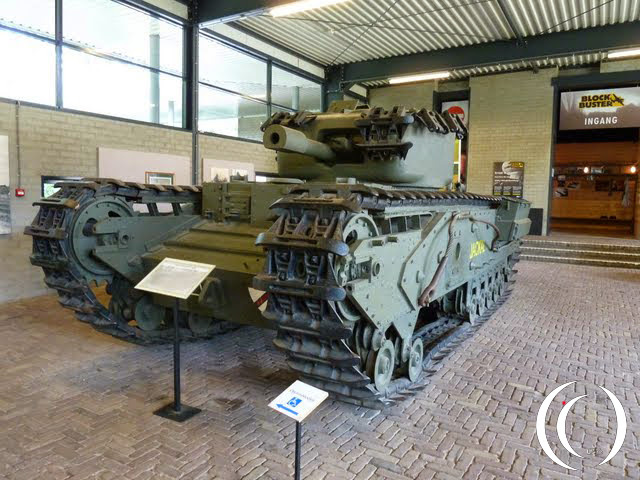
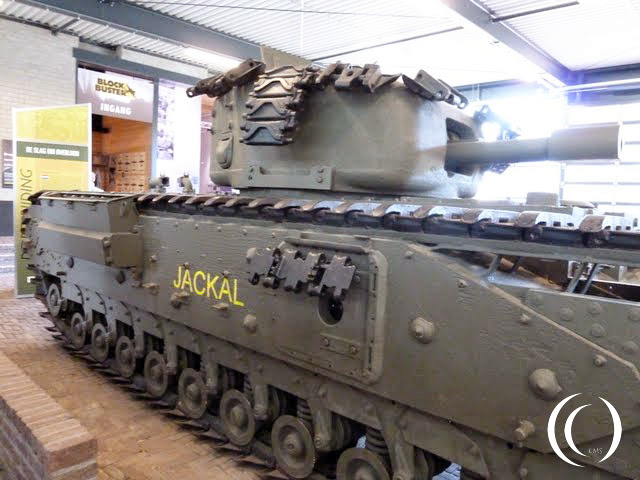
A Churchill tank called “The Jackal”
The Jackal, as the crew called this particular Churchill-tank, was in the second squad HQ troop commanded by Captain Dick Mc Dougal. On October the 12th in 1944 it fell victim to the newly developed German Riegel mine. After the explosion the Jackal burst into flames. The explosion tore out the bogies on the left side and penetrated the thick belly plate causing heavy casualties to the crew. Captain Mc Dougal lost a leg, and Jonathan Lambert lost both his legs. Bob Dare suffered severe burns after helping Mc Dougal and Lambert out of the burning tank, the two other crew members, Gordon Wright and Robert Silman lost their lives in the explosion.

After the War Mr. Lambert learned from other Coldstream guards that the Jackal was on display in the museum in Overloon, he and his wife went to see it in 1972. The Churchill tank still carries the scars of the explosion from this day in 1944.

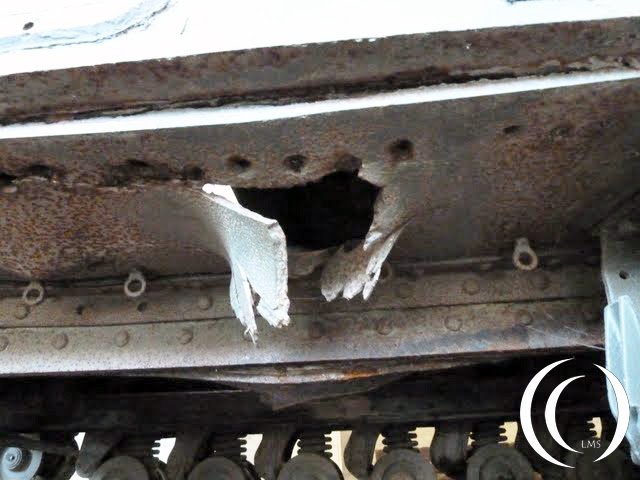

Prelude to the battle for Overloon
The 4th Battalion of the Coldstream Guards originally was an infantry unit, later it became part of an armoured division. Mr. Lambert was a driver-mechanic on a Churchill tank. He landed on Juno beach 14 days after D-Day. He and his battalion joined the 6th Guards Tank brigade and advanced into Northern Europe.
The Battalion went into action at Caen in Operation Goodwood and saw action at Overloon in the Netherlands to clear a path for an American advance. The three day battle at Overloon started on the 12th October 1944, the same day the Jackal hit the Riegel mine.

The fighting in the Overloon area was bitter; the Dutch meadows were like bogs for the tanks and heavy equipment. The fields were full of mines and tactical placed anti tank guns. The German Fallschirmjäger from General-Oberst Kurt Student together with the 107th Panzer Brigade defended the area fiercely. Their objective was to hold the line and pin down as many Allied forces as they could.
Note: the rank of General-Oberst is a German rank, above General and below Field Marshall.
Operation Herbstnebel / Wacht am Rhein, or the Ardennes offensive, was in full preparation. Therefore it was of vital importance for the German Wehrmacht to hold the line and lure as many Allied forces out of the Belgium Ardennes as possible.
The Fallschirmjäger (German paratroopers) and 107 Panzer Brigade prepared an operation to the North of the Battle of the Bulge, Operation Wanssum Bridgehead (Schneeman).
Operation Nordwind (north wind), a trust to the south of the Ardennes offensive into the French Vogese, was strengthened by the Gebirgsjäger division which just arrived from Scandinavia.
It is not widely known that the Ardennes offensive was bigger than the attack into the Ardennes. With these three combined thrusts the operations had to achieve the recapture of the port of Antwerp and to cut off the Northern Allied forces in the Netherlands and take them out of action. The northern and southern operations followed the Ardennes offensive with a slight delay, Nordwind would start on 31 December 1944, and the Wanssum Bridgehead would start at the beginning of January 1945.




The Battle for Overloon
26th September 1944 – 16 October 1944
The Battle for Overloon has many names, “The forgotten Battle”, “The tank battle at Overloon” or “The second battle of Caen”. The Battle of Overloon is a part of Operation Aintree.
After operation Market Garden a small stretch of the Netherlands was liberated between Eindhoven and Arnhem. Slowly this stretch of land was widened and the advance towards the town of Overloon was swift.
On 26th of September 1944 the American 7th Armored Division reached Overloon, where the German 107 Panzer Brigade had dug in. The first 4 days both army groups hit each other with artillery. On September the 30th the Allied assault commenced. It was the beginning of one of the fiercest battles of Western Europe.
For nine days the Allies tried to breach the German lines with Sherman tanks. Again and again they were repelled by the German defences. Mine fields, 88mm anti tanks guns, Panther tanks, Nebelwerfer artillery and infantry seemed too strong for the assailants. The German snipers tied themselves to the trees, in case of getting hurt they would be held up in the trees so they could fight on as long as possible.
On the 8th of October the worn out American forces pulled back to be replaced by fresh British troops.
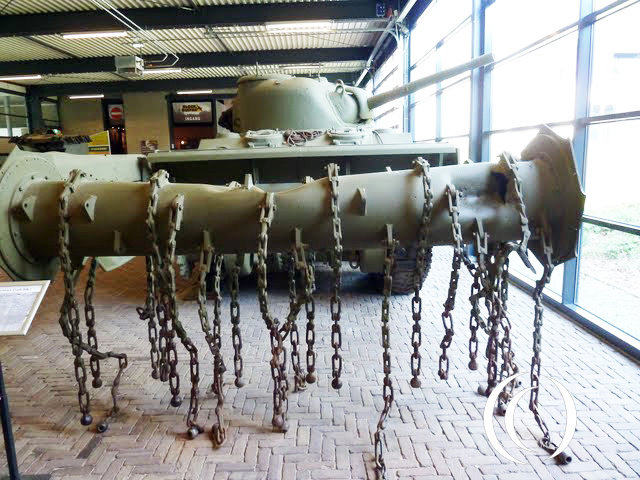
After a few days of relative peace on the battlefield a new assault should commence, but due to bad weather it was postponed for another day. The surrounding meadows of the town of Overloon had turned into a big mud pool causing the tanks to get stuck in the fields. House to house fighting in Overloon and man to man combat in the woodlands by infantry was the result with a staggering high loss of men. The Germans however did not surrender, even after they shot their last bullet they charged with their bayonets. On October the 14th the last German stronghold in Overloon eventually fell into British hands. The last 20 SS soldiers in the town, who fought from the church, were overpowered. Around one hundred German Soldiers surrendered on this last day.

No surrender
German resistance wasn’t broken after the loss of Overloon, in the woods surrounding the town German forces regrouped and fought on. The British forces slowly moved forward. Near the village of Molenbeek the fields lay strewn with mines. The German army even placed mines at the bottom of the Loobeek creek. Due to bad weather the small brook was now 6 meters wide. The German Army prevented the British soldiers from building crossings over the creek for a long time, but they eventually succeeded. After the tanks crossed the bridge they got stuck in the muddy fields on the other side. Under a murderous gun fire the British infantry tried to get to the other side of the creek, using the bridge or wading through the mine filled brook. The brook coloured red with their blood and was called ‘Bloedbeek – blood stream’ thereafter.
On the evening of October the 16th they succeeded and massively crossed the creek. Three days later they liberated the city of Venray after heavy house to house fighting.
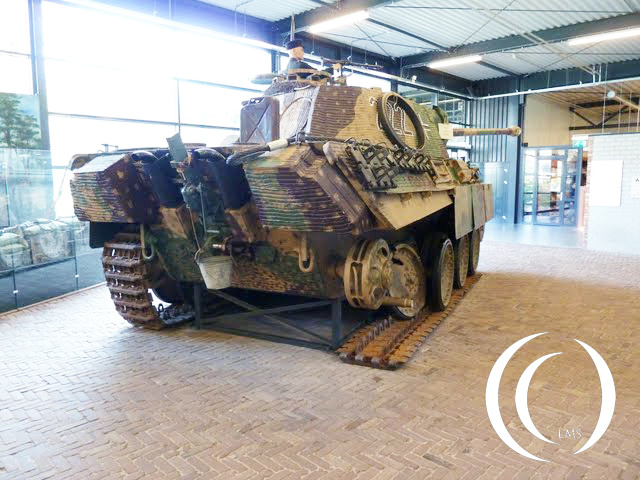
A Bitter Victory
A destroyed town of Overloon was left behind.
In and around Overloon some 2500 men died, making it one of the bloodiest battles in the Netherlands during World War Two. To give you a small comparison of the numbers; between 1500 to 1800 Allied soldiers were killed during Operation Market Garden and about 2500 Allied soldiers were killed on D-Day (numbers originate from 2012).
The Allied forces lost 3 planes, about 40 tanks and nearly to 2.500 men, and 300 civilians. A civilian from Overloon suggested that the battleground with the demolished armoured pieces should be left behind as a base for a museum. This was the start of the War Museum at Overloon. General Whistler, commander of the British forces, opened the museum on the 25th of May in 1946.
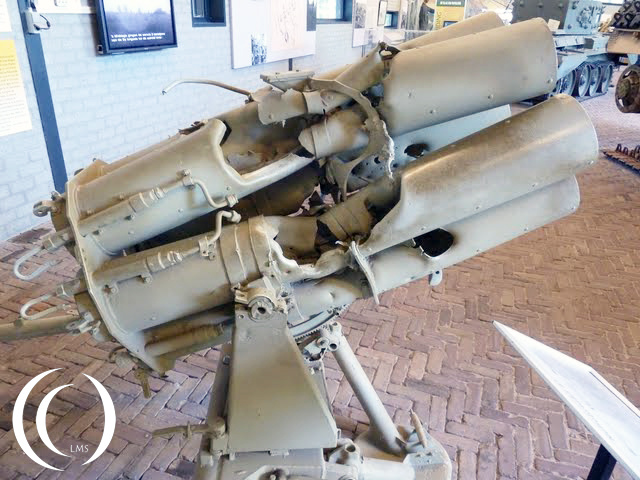
Overloon Today
Two memorials stand on the battle site today. The Norfolk monument can be found on the bank of the Loobeek creek, where the road from Overloon to Vernray crosses the infamous creek. It is dedicated to the Royal Norfolk Regiment. The liberation of Venray is one of their battle honours. The other memorial is to be found on the museum grounds. The memorial in the museum park reads the following;
Take a pause visitor, and consider that the ground you now occupy was once one of the most fiercely contested sectors of the Overloon Battlefield. Bitter hand-to-and combat ensued here. Many young lives, having escaped from the battlefields of Nettuno and Normandy met their ends under these trees.

The jackal Tank Crew After the War
After the war Bob Dare returned to civilian life as police officer, Dick Mc Dougal returned to London and Jonathan Lambert took up work as an inspector with the General Electrical Company.
He kept on riding motorcycles and was well known for his involvement with the Borehamwood branch of the Royal British Legion. Unfortunately he left us a few years ago.

Visit the Jackal at Overloon War Museum
You can visit the Jackal in the Overloon War Museum. It stands together with other victims of the battle, armor like a Cromwell tank, a Sherman Crab (flail tank), a German Panther tank and a Nebelwerfer smoke grenade launcher, all left behind on the battlefield in or around the city of Overloon. (Museum situation in 2013, check the museum’s website for the latest updates).
Note: There is a little dispute on the date the Jackal was taken out of action. The tombstones and Commonwealth War Graves Commission dates refer to October the 14th 1944, Bob Dare a firsthand veteran of the Battle of Overloon and other sources speak of October the 12th in 1944. We know dates and information gets mixed up and complicated during the war due to the chaos in battles. D dates can be mixed up or lost after reburying the fallen soldiers. Beside that memories are fading as years are passing by, even to the men who fought during the actual battle. After 80 years the exact information can be hard to find or is blurred, even for official information sources. In this article we mentioned the date given by us from Bob Dare’s letter.
Excellent and provides great reference material! Nicely done folks!
Thank you!
Thank you for this article on a often forgotten event in the war in Europe. I was especially interested in the part about the Churchill tank “Jackal” of 4th (Arm’d) Btn Coldstream Guards as my late grandfather also took part in the battles as a serjeant-tank commander in 4th (Arm’d) Btn Grenadier Guards, part of the same armoured brigade. Hopefully, the wife and I will be able to get over to Overloon at some point this year or next and pay yourselves a visit. Please keep up the good work.
Ian Dunn
Interesting…I was a wireless operator/ loader on Cheetah of Number 2 Squadron and was alongside Jackal when it blew up. My old mate, Bob Dare was on that tank and unfortunately we were unable to stop. I was convinced that Bob was dead and it was only later I found out what the casualties were. I stayed in contact with Bob after the war and met him a few times until he died a few years ago
It was good to hear Jonathan led a full life after the war despite his appaling injuries
Hello. My name is Don Roper. My father was squadron sergeant major Herbert Hughes Roper. Bert. I would be delighted to be put in contact with anybody who knew him. He was with number three squadron 6th Guards Tank Brigade. He passed away some years ago, but he told me quite a lot through a long and contented life.
My father was Herbert Hughes Roper, Bert. He was Squadron Sergeant Major of three squadron Coldstream Guards 6th Guards Tank Brigade. He passed away ten years ago after a long and happy life. I would be delighted to connect with anyone who served with him. I have quite a lot of information and some photos. And lots of questions.
Sorry……As you can imagine there was little contact with other members outside of your own Squadron and I cannot recollect coming into contact with your father. My best wishes to you
Thank you for getting back to me John. Would you know anything about a story that turret guns were taken from a crashed bomber and welded onto a scout car? It’s one of the things my dad told me about. There’s quite a lot more if you would like me to stay in touch. One other thing. I was in the second Battalion in the sixties and seventies and think I remember a lad called John Collier. Any relation?
Don…The story about the turret guns is new to me but I have no reason to doubt it as there was a lot of adaptation going on at the time. Glad to know you were fellow Coldstreamer but the only relation I had in the Coldstream was my Grandfather who served in the Boer War
Only too glad to help with any query you may have, but at 90 years of age my memory is somewhat limited
Wonderful article. I feel for your concerns about the attribution of crew members, which were completely wrong. The commander was Capt Dick McDougal (my godfather) who lost a leg, and has only recently been corrected. I know this because it is Patrick Forbes history of 6th Guards Tank Brigade and also my father commanded Jaguar so was at the battle.
There seems to be a little confusion regarding the crew of Jaguar at the time of the incident The crew were as follows:-
2665338 Gds Robert Dare..Severe burns Driver
2665937 Gds Robert Silman ….Killed Turret
2666077 Gds Gordon Wright….Killed Turret
2661079 L/Sgt Johnny Lambert…..Wounded Co.Driver
2661529 L/Sgt L. Garner…….Wounded Tank Commander
Dear John, referring to your earlier reaction, summing up the tank crew starting with Robert Dare; is this the crew of the Jaguar or the Jackal? There seems to be some confusion about this.
Pascal
Pascal.
My apologies…Old age is catching up on me…It should of course read the Jackal NOT the Jaguar
Hello John – the commander of Jackal was not L/Sgt Garner, it was Capt McDougal and he lost a leg in that incident. This confusion has arisen quite recently, but not sure why. My father, then Capt Rowsell, was commander of Jaguar.
Dominic
I am sorry that there is some dispute over who was on the crew of Jackal on that fateful day but I base my findings on a letter from the driver Bob Dare
I Quote:-
” I remember getting ready for the attack during the morning. My crew were made up of Sgt Garner, L Commander, myself,the driver, Gds Bob Silman and Gds Gordon Wright,turret men, and my co driver was L.Sgt Johnny Lambert. Johnny Lambert only came to join us the day before from another tank which had been blown up and my original co-driver had received injuries which made it impossible to take part in any action.”
As there were a number of casualties that day and a number of tanks damaged, for the sake of clarity I would be pleased if you could tell me on what basis you state that Capt McDougal was in command of Jackal.
Bob Dare goes into some detail regarding the subsequent action and I would be only too pleased to furnish you with a full copy of the letter.
My regards….John
Hi John, I have feeling Bob Dare is confusing things and is thinking of Cougar or Caribou in #3 Troop. The tank in the Overloon museum is a Mk V with a 95mm and these were only in the HQ troops and HQ troop tanks were all commanded by officers. No 2 Squadron 95s being Jackal (Capt McDougall) and Jaguar (my father’s). The reason Jackal was alone when it hit a mine was it was travelling to an Ops meeting after the action on 13th October. The bad day for casualties for #2 Squadron was 14th October when they met mines and 2 Panthers.
Best
Dominic
Hello John Collier. I’m sorry to have misled you regarding your possible relative. My old memory is beginning to warm up, and i now realize the lad I was thinking of was called John COLLEY. Close. But not close enough. I’ve had a letter from Patrick, of this website. I’ve sent him a photo of the 4th Battalion Sergeants Mess in 1942, together with the nominal roll. I hope he posts it on here, I’m sure he will. It has people you may know. Colonel Gwatkin is in the center. My Dad knew him and spoke well of him. I met him once at an old Coldsreamers do in Ipswich, Suffolk. There of lots of names I’m coming across that are the same as people I served with, and likely their fathers.
My best regards to you.
Don Roper.
Hi I am really intrigued by this correspondence as I am planning to take my mother and father to Overloon this spring to visit the grave of Robert Silman who was one of the crew of Jackal and who died when it blew up. He was my dad’s cousin and although he was only 19 at the time of his death my father was half his age and really looked up to him. He has always wanted to visit his grave.
Interestingly the CWGC has 14th October as the date of their death whilst Robert Dare’s account in the IWM says 12th October. The CWGC records online also shows that the crew were initially buried south east of Overloon near the Overloon-Venray road and in open countryside between the woods and the Moolenbeek. That suggests that it was more likely to be the 14th and if that is so it was when 2 Sqn was supporting the 1st Norfolks who pushed down the road.
I would be really interested if anyone could confirm this and particularly would like to correspond with John Collier on the matter.
Best wishes
Tony Honeyman
Tony
It is nice to know that you will be paying your respects to your relative and that he has not been forgotten.
I regret that I am unable to confirm the exact date of his death although the incident is quite fresh in my mind.
My best wishes to you and your family.
JOHN
Hi John
Many thanks for replying. I know it is a long, long time ago but would you have anything to add to the account of the incident that would help me narrow down the date and place. Even just your recall of the events would be useful.
The War Diary of 4th Coldstream Guards is remarkably thin on the battle of Overloon and Venray and that of 6th Guards Tank Brigade has more but still far from a detailed account. For others researching this Patrick Forbes book ‘6th Guards Tank Brigade’ is the most useful whilst I always find the recorded recollections in the IWM collection add a feel from those who were there.
Again thanks
Tony
Tony.
You will have to understand that my view during any of the engagements I was involved in was very limited. It was normaly hatches closed and my only view of the outside world was through the periscope. I was very busy loading the 75mm gun. supplying the BESA machine gun with belt fed ammo.,working the wireless and the smoke mortar all in a confined and very small place.
My memory of Overloon is mainly confined to arriving at the startup line. I got out of the tank and saw a line of soldiers resting by a hedgerow and then the dreaded sound of the Moaning Minnies. I dived into a nearby ditch and a few seconds later was surround by exploding mortar bombs. Much to my surprise the soldiers hadn’t gone for cover and I then realised that they were all dead and had been laid there by the stretcher bearers.I saw in the distance Typhoon planes strafing a line of trees…a welcome sight.
On startup, through my periscope I caught a glimpse of Jackal blowing up.
I regret that all this is of very little use to you as I have no idea of the exact date or the exact location
By the way, have you read The Forgotten Battle, Overloon and the Maas Salient, available through Amazon ?
Sorry I can’t be of more help
John
Dear John.
I have been re-reading Patrick Forbes book on 6th Guards Tank Brigade and found myself looking at this website about the tank Jackal. You mentioned that you were the wireless operator/loader in Cheetah. That was my Uncle’s, Captain John G H Barton, tank. Sadly he died a long time ago (1955) and I hardly new him, but you must of known him!. He had made a few comments in the book one being,” In Holland, I returned at Overloon to the battalion, to find all my troop had been knocked out!” I hope that you are keeping well and that my uncle was a good commander!
Yours
Charlie Barton
Hi Tony,
My name is Tom Blears and I am presently writing a book relating to the 4th Battalion Coldstream Guards. I can confirm that your relative was killed on October 14th 1944, not the 12th. I retrieved this information from the battalion diary which coincides with C.W.G. records. No 2 Squadron was held in reserve during the attack on Overloon on October 12th but did see action on the approach to Molbeek canal on the 14th.
I trust this helps you.
Tom Blears.
P.S. Hopefully my book swill be published next year – the proposed title being “Churchill’s Butchers”, the name given to the battalion following the assault on Hill 309 during the Normandy campaign.
Hi
This is Christine, johnny Lambert’s daughter.
The date that the Jackal was blown up was the 13 th October, the commander was McDougall, and my Dad alwsys said they were on an ops mission and not actually in a battle when they went over the landmine.
I hope this helps clarify some issues. Bob Date’s story doesn’t tie in with Dad’s or Forbes.
Regards to all
Christine.
To Christine Lambert, I’m Nick Frost my father was the driver of a churchill tank in the 4th battalion coldstream guards armoured unfortunately my father died in 1993 I remember he only seemed to tell me about mainly funny things during is time in the war not too much about things that I would love to know now I’m still awaiting is war records if any from Glasgow but on talking to various people I’m finding snippets my father’s tank commander was squadron sargent major V C DUFFIELD so I know where ever he was so was my father now having seen the tank crew rosters on ww2 talk v c Duffield was in headquarter squadron and I know he was in charge of a churchill tank of which my father was a driver I know there are only two main battle tanks in headquarter squadron EAGLE and SEAGULL so it’s looking increasingly likely my father was the driver of seagull the adjutant tank in headquarter squadron I have all the usual IWM photos that he brought home after the war but all he ever said about them was that was our mob anyway I could go on and on but hope you may know something or someone that could shine more light on the subject many thanks nick frost
Sorry that should say Bob Dare’s